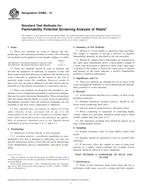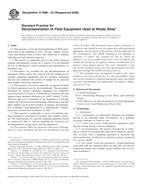Potřebujeme váš souhlas k využití jednotlivých dat, aby se vám mimo jiné mohly ukazovat informace týkající se vašich zájmů. Souhlas udělíte kliknutím na tlačítko „OK“.
ASTM D5233-92(2009)
Standard Test Method for Single Batch Extraction Method for Wastes
Automaticky přeložený název:
Standardní zkušební metoda pro jedinou skupinu extrakční metoda pro odpady
NORMA vydána dne 1.9.2009
Informace o normě:
Označení normy: ASTM D5233-92(2009)
Poznámka: NEPLATNÁ
Datum vydání normy: 1.9.2009
Kód zboží: NS-30384
Počet stran: 9
Přibližná hmotnost: 27 g (0.06 liber)
Země: Americká technická norma
Kategorie: Technické normy ASTM
Kategorie - podobné normy:
Anotace textu normy ASTM D5233-92(2009) :
Keywords:
batch, extraction, laboratory, leaching, single, sludge, solid, solidified, testing, waste, Batch procedures, Extraction methods, Laboratory environmental analysis, Leachates/leaching, Municipal solid waste (MSW), Sampling waste materials/applications, Single batch extraction, Sludge, Solid phase materials--waste, Waste materials/processing/analysis, ICS Number Code 13.030.40 (Installations and equipment for waste disposal and treatment)
Doplňující informace
| Significance and Use | ||||||||||||||||||
|
This test method is intended to generate an extract with a concentration of the target analyte(s) representative of the expected release under the scenario simulated, and which can be compared with concentration levels acceptable in waste disposal, treatment, or production activities. The extraction conditions of the test method were chosen to simulate a potential disposal scenario to which the wastes may be exposed. One intent of this test method is that the amount of acid in the extraction fluids reflect the acid available from the leachate of a specific landfill where municipal and industrial wastes were co-disposed. One intent of this test method is to not allow the pH of the extraction fluid to be lower than that of the leachate of a specific landfill where municipal and industrial wastes were co-disposed. Therefore, the pH of the extraction fluid was chosen with the following considerations: (1) Not to be less than 4.93 ± 0.05 for the extraction of wastes with an acid neutralization capacity of less than the acid available in the total volume of extraction fluid used in the method (Extraction Fluid No. 1). (2) At 2.88 ± 0.05, as defined by the pH of the acid, for the extraction of wastes with an acid neutralization capacity of more than the acid available in the extraction fluid used in the method (Extraction Fluid No. 2). The interpretation and use of the results of this test method are limited by the assumptions of a single co-disposal scenario and by the factors affecting the composition of a landfill leachate and chemical or other differences between a selected extraction fluid and the real landfill leachate. This test method may be affected by biological changes in the waste, and it is not designed to isolate or measure the effect of such processes. This test method produces extracts that are amenable to the determination of both minor and major constituents. When minor constituents are being determined, it is especially important that precautions be taken in sample storage and handling to avoid possible contamination of the samples. The agitation technique, rate, liquid-to-solid ratio, and filtration conditions specified in the method may not be suitable for extracting all types of wastes. This test method is intended to extract the samples in their original physical state as is, without any size reduction. However, the sample/extractor interaction is expected to correlate with the environmental conditions to which a waste may be exposed. The extraction conditions defined by this test method are expected to yield steady-state concentrations, determined by the extraction liquid-to-solid ratio and the duration of the extraction, which may or may not agree with the concentration of an equilibrium. |
||||||||||||||||||
| 1. Scope | ||||||||||||||||||
|
1.1 This test method is applicable to the extraction of samples of treated or untreated solid wastes or sludges, or solidified waste samples, to provide an indication of the leaching potential. 1.2 This test method is intended to provide an extract for measurement of the concentration of the analytes of concern. The measured values may be compared against set or chosen acceptance levels in some applications. 1.3 If the sole application of the test method is such a pass/fail comparison and a total analysis of the waste demonstrates that individual analytes are not present in the waste, or that the chosen acceptance concentration levels could not possibly be exceeded, the test method need not be run. 1.4 If the sole application of the test method is such a pass/fail comparison and an analysis of any one of the liquid fractions of the extract indicates that the concentration of the target analyte is so high that, even after accounting for dilution from the other fractions of the extract, it would be equal to or above an acceptance concentration level, then the waste fails the test. In such a case it may not be necessary to analyze the remaining fractions of the extract. 1.5 This test method is intended to provide an extract suitable for the measurement of the concentration of analytes that will not volatilize under the conditions of the test method. 1.6 Presence of volatile analytes may be established if an analysis of the extract obtained using this test method detects the target volatile analyte. If its concentration is equal to or exceeds an acceptance level for that analyte, the waste fails the test. However, extract from this test method shall not be used to determine the concentration of volatile organic analytes. 1.7 This test method is intended to describe only the procedure for performing a batch extraction. It does not describe all of the sampling and analytical requirements that may be associated with the application of this test method. 1.8 The values stated in either SI or inch-pound units are to be regarded as the standard. The values given in parentheses are for information only. 1.9 This standard does not purport to address all of the safety problems, if any, associated with its use. It is the responsibility of the user of this standard to establish appropriate safety and health practices and determine the applicability of regulatory limitations prior to use. For a specific precautionary statement, see Note 8. |
||||||||||||||||||
| 2. Referenced Documents | ||||||||||||||||||
|
Podobné normy:
Historická
1.9.2012
Historická
1.9.2012
Historická
1.9.2012
Historická
1.12.2010
Historická
1.1.2012
Historická
15.9.2008



 ASTM D4979-12
ASTM D4979-12 ASTM D4981-12
ASTM D4981-12 ASTM D4982-12
ASTM D4982-12 ASTM D5057-10
ASTM D5057-10 ASTM D5058-12
ASTM D5058-12 ASTM D5088-02(2008)..
ASTM D5088-02(2008)..
 Cookies
Cookies
